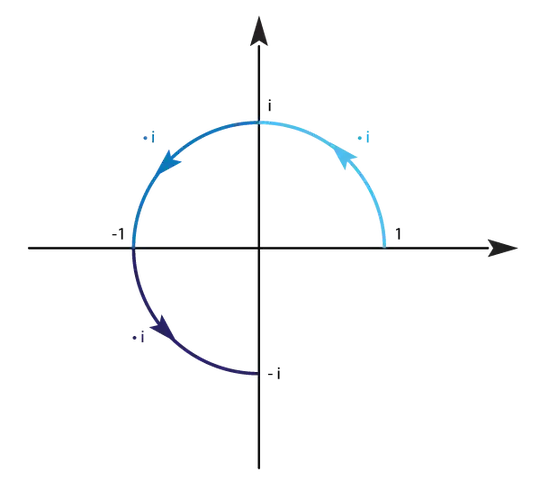$$i^3=iii=\sqrt{-1}\sqrt{-1}\sqrt{-1}=\sqrt{(-1)(-1)(-1)}=\sqrt{-1}=i $$
Please take a look at the equation above. What am I doing wrong to understand $i^3 = i$, not $-i$?
$$i^3=iii=\sqrt{-1}\sqrt{-1}\sqrt{-1}=\sqrt{(-1)(-1)(-1)}=\sqrt{-1}=i $$
Please take a look at the equation above. What am I doing wrong to understand $i^3 = i$, not $-i$?
Since $i^2=-1$ by definition, $i^3=i^2\cdot i=-i$.
$\sqrt{a}\sqrt{b}=\sqrt{ab}$ is only guaranteed for positive real $a$ and $b$.
We cannot say that $\sqrt{a}\sqrt{b}=\sqrt{ab}$ for negative $a$ and $b$. If this were true, then $1=\sqrt{1}=\sqrt{\left(-1\right)\cdot\left(-1\right)} = \sqrt{-1}\sqrt{-1}=i\cdot i=-1$. Since this is false, we have to say that $\sqrt{a}\sqrt{b}\neq\sqrt{ab}$ in general when we extend it to accept negative numbers.
I'm sure everyone has answered the question appropriately. But here's my 2 cents:
From the Argand plane perspective, multiplying a complex number by $i$ is equivalent to rotating it about a circle (with radius = modulus of complex number) counterclockwise by 90 degrees. So ask yourself where you end up when you take $i$ and multiply it with $i$ twice.
$\sqrt{ab} = \sqrt{a} \sqrt{b}$ is correct in the following sense: In an arbitrary field (here it is the field of complex numbers) the root $\sqrt{a}$ is an element in some field extension such that $\sqrt{a}^2=a$. It is not uniquely determined, for if $b$ is a root, then also $-b$ is a root (and these only coincide when $a=0$ or the characteristic is $2$). Now the correct statement is:
If we define $\sqrt{a}$ to be the set of all roots of $a$, then $\sqrt{ab}=\sqrt{a}\sqrt{b}$ even holds verbatim. For example, $\sqrt{-1}=\{\pm i\}$ then, and $\sqrt{(-1) (-1)} = \sqrt{-1} \sqrt{-1}$ holds since both sides equal $\{\pm 1\}$.
If $a \in \mathbb{R}^+$, one usually denotes by $\sqrt{a}$ the unique root of $a$ in $\mathbb{R}^+$, but this definition doesn't work properly for complex numbers or other fields.
When you write $i=\sqrt{-1}$ then this is something that is sometimes useful and sensible, but really has to be done with care. All that really says is that $i^2=-1$, and of course $(-i)^2=-1$ holds as well. So correctly your calculation only yields $$(i^3)^2=i^2\cdot i^2\cdot i^2=(-1)(-1)(-1)=-1=i^2,$$ which is true.
Multiplying by $i$ in the complex plane amounts to a counterclockwise turn of $90$ degrees. Hence it is geometrically clear that $i^3 = -i$, as the following drawing shows

Regarding your equations, as remarked already, $\sqrt{a}\sqrt{b}=\sqrt{ab}$ holds only for positive real $a$ and $b$, so you cannot use it with complex numbers.
$\sqrt[n]z$ does not return a single value, but n complex values. Hence your confusion, since both i and $-i$ are among the square roots of $-1$.
Here is the Simple Answer to this question
as $i^2=-1$, if you break $i^3$ into $i^2\cdot i$ then you insert $-1$ into the place of $i^2$ you will get $(-1)\cdot i =-i$
this is the simple trick behind it.
Someone posted earlier that it is i x i x i which is -1 x i, ie -i (but the post seems to have been deleted!
But that's all there is to it. It doesn't matter what i represents, the algebra will be consistent. But to prove it, substituting the value of i, ie (√-1), you get
√-1 x √-1 x √-1 = -1 x √-1 = -(√-1) = -i
However it may be worth mentioning that i is not a complex number as has been suggested - it is an irrational number. A complex number is of the form (x +iy)